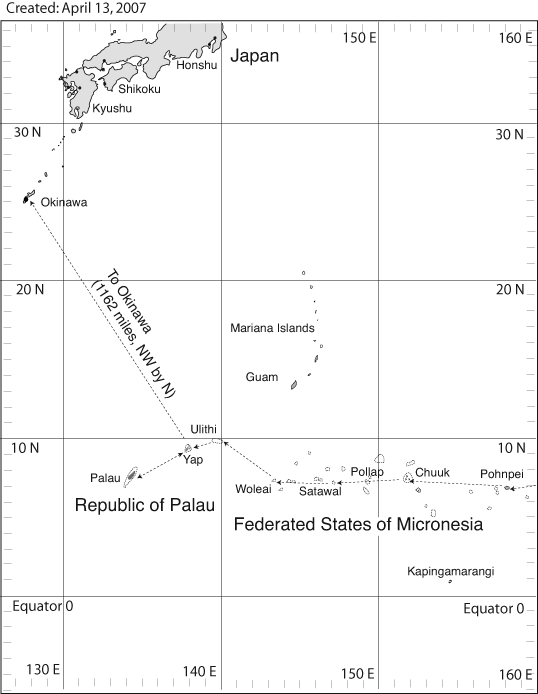Ku Holo Komohana: Voyage to Japan 2007
Okinawa, Amami, and Kumamoto (April 12-May 7)
April 12 - 23 Yap To Okinawa
Hokule'a and the escort boat Kama Hele left Colonia, Yap, at about 3pm Thursday Yap time.
Captain and Navigator Nainoa Thompson says they had a good enough glimpse of the sun to set a course north and although tonight is cloudy with squalls, there are no storms and as the squalls go by the wind always returns to light easterlies at 5 to 12 knots, so no dangerous winds.
Also on board Hokule'a are Timi Gilliom of Maui, Atwood Makanani, Ka'iulani Murphy, Dr. Pete Roney, Pomai Bertelmann of Hawai'i Island, Chadd Paishon of Hawai'i island, Taku Araki of Japan, Kana Uchino of Japan, Kaina Holomalia, and Maile Neff. Thompson expects this 1162-mile leg from Yap to Okinawa will take an estimated 12 to 14 days.
Crewmembers are enjoying a dinner of fresh cooked aku tonight.
Aloha, Kathy
April 12 fishing report: two aku and two mahimahi
Yap has been good to us!! On Tuesday evening we were treated to an evening on the beach at the Village View Hotel put on by the Yap Voyaging and Navigation Society. Much of our time was spent dancing on the beach to the awesome music played by the local band. With a bit of coaxing by Sesario's girls we were able to have 'Onohi share with us his "sailing" rendition of No Woman No Cry and Three Little Birds. As the night drew to a close we were sad to leave but we are fortunate to be able to add another wonderful group of people to the growing family of the wa'a.
Following our Wednesday morning meeting Nainoa and Chadd made the decision to stay in Yap for another evening to take care of last minute logistics. This gave us time to say aloha to Na'alehu, Eric, Pauline, Emily and Keoni who made the trek home to Hawai'i to be reunited with their families. Their first of three flights that departed at 5am would take them through Guam and then Narita before landing in Honolulu. Our departure at 3pm would take us from Yap straight to Itoman, Okinawa via the Pacific Ocean. Sesario and Atarino headed out of the channel before us yesterday and caught us few rat aku for our dinner. Just as they dropped the fish over to us our line hooked and aku too! When we have fish, everyones happy! Taku and Kana made a great "White Stew" with the fish, everyone loved eating it. The evening brought us bunches of rain but in the early morning we were greated by the sun and flat water and clean wind. We are making good headway, Mahalo ke Akua!
Today has been another great day on the ocean, two aku and two mahi to report. Timmy made the poisson cru, Kaina made the poi, Kana made the dip and we feasted well. All watches are doing a great job holding the line, this is good practice for when we get into the cold and the rough, everyone's in good health and spirits.
We look forward to another great evening of learning and experinces gained upon the face of the sea. Mahalo no to all of you at home for your love and support.
Hokule'a Yap to Okinawa Crew
na, Pomai
April 13 increasingly clear weather, with tradewinds
Hokule'a captain and navigator Nainoa Thompson said that the clouds parted enough last night to reveal the star Atria, which is an indicator of direction and latitude: when Atria lines up directly under a star that Thompson calls Willy - after his mentor and former Bishop Museum planeterium lecturer Will Kyselka - then Atria is crossing the meridian at its highest point in its transit across the night sky; and an imaginary line from Willy through Atria points south. Also, the closer to the horizon Atria is when it transits the meridian, the farther north Hokule'a is, so he was pleased to see Atria as low as it was, indicating they are making good progress north; he estimates they should pass 15 degrees north latitude sometime tonight.
Hokule'a and the escort boat Kama Hele, under captain Mike Taylor, have been sailing under increasingly clear weather, with tradewinds helping them to speed along. However, Thompson says the winds are starting to turn south of east and are weakening, possibly ahead of a cold front.
Both captains say crewmembers are doing well. They still estimate 12 to 14 days to reach Okinawa. They left Colonia, Yap Thursday Yap time (Wednesday night, Hawai'i time).
Aloha, Kathy
[PVS Note: Atria is in the constellation Trianguli Australis (Southern Triangle], below Maui's fishhook, or Scorpio, as these constellations cross the meridian above due south. Willy is possibly the star Eta Arae. At 15 degrees north latitude, Atria transits the meridian at about 6 degrees above the horizon. At South Point on the Big Island (19 degrees N), Atria crosses the meridian about 2 degrees above the horizon. On Kaua'i, at 22 degrees N, Atria cannot be seen; on Okinawa, at 26 degrees N, it is also below the horizon when it transits the meridian. For a discussion of meridian pairs and latitude determination, see http://archive.hokulea.com/navigate/latitude.html .]
April 14 eleven individuals, but together, we are one family
Hokule’a set sail from Yap on 12th April for the second part of our voyage--Ku Holo La Komohana. With a warm farewell from the island people, we began the 1200-mile journey to our first destination, Okinawa. Maisu, the youngest canoe in the genealogy of canoes, who traveled for the last three months with Hokule’a, stayed in Yap. Maisu will begin her own journey to perpetuate the navigational skills based on the Yapese traditions. The organization in charge of Maisu was named by Mau “Lam Lab”, meaning “big ocean” in their language. Mau’s son Sesario and many others are committed to develop the programs using Maisu. Over the next few years many stories, experiences and lessons that will help to build and define the personality and character of Maisu.
After sailing through a half day of rain, we were blessed with a calm weather and have been soaking it up ever since. We are now heading Na Leo Ho’olua (NNW) on Kukulu o kalani (the Hawaiian star compass). The Na Hiku (big dipper) is on our bow and Hanaiakamalama (southern cross) is at our stern. Ka makau nui o Maui (Scorpio) is also bright in the southern sky, and the navigator’s triangle is watching over us in the east.
We are eleven individuals, but together, we are one family, the family of the canoe. We are working for the same purpose with one heart. To all of our family and friends who helped us to get here, and to those who are watching over this voyage from a far, the spirit of each one of you is here on this canoe with us. Thank you so much for your support. You are in our prayers. Mahalo. Malama pono.
Kanako Uchino
ホクレアより日本のみなさん、こんにちは!
ハワイイからミクロネシアまで2ヶ月半にわたる航海を無事終えたホクレアは、4月12日、いよいよ日本に向けての航海を始めました。Ku Holo La Komohana (東の空 への航海)と名づけられた、総航海距離4300キロ、約2月半の旅のはじまりで
す。ヤップ島の人々のあたたかな見送りを受けながら、わたしたちは最初の目的地、沖縄に向けて、ゆっくりと帆を開きました。
これまで一緒に航海を続けてきたもうひとつのカヌー、マイスは、ヤップ島に残ります。マイスはこれから、ヤップ島を拠点に、ミクロネシアの伝統航海を次世代へとつなげる活動をしていきます。マイスの航海を担う団体は、「ラムラブ」と名づけられ
ました。名づけたのは、ハワイイに伝統航海術を蘇らせた航海術師マウ・ピアイルグ、彼の故郷サタワル島の言葉で「大きな海」という意味です。マウの息子セサリオ を始め、たくさんのミクロネシアの若者たちが、マイスを使って航海術の伝統を継承
していく活動をすでに始めています。マイスはこれから、ミクロネシアに数多くの新 たな伝統と物語を生みだしていくでしょう。
出航してからしばらく続いた雨の後は、とても穏やかな天候に恵まれながら航海を続 けています。沖縄に向けての針路は、ハワイのスターコンパスで、ナレオ・ホオル ア、北北西に向かっています。北斗七星をカヌーの前に、南十字星を後ろに見ながら の航海です。南の空には、釣り針の形をした大きなさそり座が輝き、天の川をはさん だ東の空には、ハワイイで“ナビゲータートライアングル”と呼ばれる夏の大三角形 が、わたしたちを見守ってくれています。
ホクレアの上、クルー11人は、ひとつの家族として、思いを共にしながら進んでいます。わたしたちが今、ここにいられるのは、これまで支えてきてくれた人々の存在 があったからです。家族、友、そしてこの航海を遠くから見守ってくれているみなさん、本当にありがとう。ホクレアに思いをよせるすべての人のスピリットが、今この カヌーの上でわたしたちと一緒に旅を続けています。見渡す限りの海から、みんなの ことを思っています。Mahalo. Malama pono.
内野加奈子
April 15 Taku's Report
ヤップ島からの航海が始まって4日目。出航時から吹き続けてきた貿易風が突然止んだ。今日は日曜だがカヌーの上では平日や週末はなく毎日が天気と一緒に過ぎていく。風がない今日は洗濯をした。通常水は飲料と歯磨きのみで食器や体を洗うのも海水を使う。よく「海水は肌がチクチクしませんか」と聞かれるがそれはタオルで水分を拭き取ることでほぼ気にならない。今日は一日風待ち状態なのでPCに向き合うことができた。航海中は画面を見ているだけで気分が悪くなってしまうので。。(笑)
ホクレアの上からは日々ラジオでグアムから気象状況が入る。この時期は既に嵐が発生する危険な季節。北緯15度前に台風が発生したらすぐに曳航でヤップに引き返すというプランだったが、無事にそのラインは越えたようだ。ヤップ(北緯9度)から26度付近まで一気に北北西に上り、それから風の様子を見ながら西へ移動し、最後のコーンに入る。(肉眼で島を捉えることができる範囲を“コーン”とよんでいる)
ナイノアが作った航海計画図はノートに簡単に手書きでまとめられていてあくまでも感覚を重視していることがよくわかる。自分はできる限りそれを勉強しようと思いそれをメモに写し毎日記録している。初日を除いて毎晩素晴らしい星空が見えている。6-10のウォッチ班に入っている自分は北極星から南十字星までのスターラインを頼りに舵を取る。昨日まで平均で7ノットの高スピードで進んできた我々は北緯16度付近まで進んできていると把握している。ヤップは暑く、慣れていない自分は熱射病にかかり軽い微熱が続いていたが、現在は夕暮れ時の気温も少し下がってきて気持ちがいい。水平線に囲まれたホクレアの上で昼寝をしてたらチャッドが弾くギターの音が夢と波紋した。ウォッチが終わり星を眺めてたら夢と現実が交差する。カイウラニからある程度の星を習ったらできる限り自分で星を見つけられるように努力しているのだけど、あまりにも星が見えすぎて特に一部が雲に隠れた星座を一瞬でわかるようになるのは難しい。
自分はライフガードとしての仕事ともう一つ大事なコックを任されている。朝と昼は軽食だが夕食は毎日しっかり調理する。日本から持ち込んだ鰹節や乾燥ホタテ、昆布が大活躍している。日本に向かうのだから日本食を食べてもらう。日本語もカナが一生懸命皆に教えているから自分は日本の味を、健康な食生活を皆に伝えたい。
今年1月ハワイ出航の時にお祈りをしたとおり、日本人としてこのホクレア号のクルーになるということはとても大きな責任があると思っている。日本を海か
April 16 last night, the ocean was like a mirror; no wind
Aloha Monday!E ala e! We were greeted with a beautiful sunrise on this windless morning out here in this great expanse of ocean, which one could mistake for a lake at the moment.
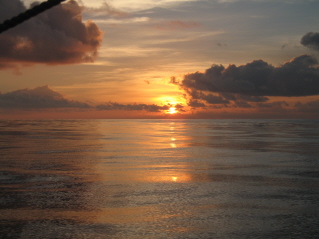
Yesterday the wind switched from ENE to ESE and lightened to a gentle breeze, if even that. Up until then we were sailing fast with four sails up, a genoa and jib in addition to the main and mizzen. Late in the afternoon we shut our main sails, put the spinnaker up and headed west as the sun neared the horizon. There wasn’t enough wind to keep it open, so before dark the spinnaker came down too. Rather than drifting forward, we are slowly rolling with the swells and Hokule’a seems to dance to the south, to the north and everywhere in between.
Dr. Pete’s birthday was the 14th, and Kanaloa gifted him with an ono on the fishing line he set out in the morning. The birthday man caught the first ono on this voyage to Okinawa, mahalo nui! We sang happy birthday to him last night, celebrated with cupcakes and were blessed with a stunning starry sky.
The ocean was like a mirror, reflecting each of the stars on its glassy surface. The horizon was concealed in the deep blue and it seemed that the ocean and sky became one. While sitting in awe of nature’s beauty, the sweet sounds of the guitar split the silence as ‘Onohi strummed familiar tunes from home. His voice with Pomai’s lifted us into a dreamworld that made the night even more magical.
Today we have opened the sails in hope to make some kind of progress in a northwest direction. It will take all our prayers, hopes and good thoughts to holomua. Mahalo to our weather forecasters who have informed us that we should have good weather through Okinawa, all we can do now is wait for the wind.
Mahalo piha and malama pono,
Ka’iulani
April 16 Reflections from Taku
4月16日(月) 航海5日目。風待ち2日目
水面は鏡のように平らで静か。昨夜は星が水面に反射し上下の感覚がなくなった。よそらを見上げながらただ時間だけが過ぎていった。気がついたら甲板でねむっていた。
一夜が明け船上でDVD視聴会が開かれた。マカが“ラスト・サムライ”を持っていたのでノートパソコンの前に皆が集まる。自分は日本の雰囲気を感じてもらおうと白玉ぜんざいを作った。ナイノアは少し興味を持っているようだったが、現在位置を常に把握しようとしているのであろう、5分ほど画面の前に立ってはまたどこかに消え、少ししたらまた戻ってくる。
映画が終わるころには夕食のカレーライスの準備をほぼ終えていた。友人が北海道から取り寄せてくれた乾燥ホタテ貝をたくさん使ったカレーライス。出来上がるまで3時間は煮込む間、自分とマカはいろんな話をした。“武士道”、そして沖縄の“ニライカナイ”という言葉にマカは反応した。彼はハワイ、カウオラベ島の出身。1月自分がいったん帰国した後、悪天候で苦労していたあの島だ。日本軍のほかにニュージーランド、そしてヨーロッパの国々に進撃され、今は米軍事訓練施設、爆撃練習場となっている島だ。彼は長い間アメリカ軍から祖先の島を守る活動を続けた。
「自分が生まれた場所を守る為に自分が存在する。
彼のこの言葉に自分の中の魂の芯に大きく響く。自分の土地、文化に誇りをもち後世につなぎ続ける。それはまさに映画の中にも出てくる侍の生き方と同じだった。ホクレアが日本に行くということは、今の日本の現状を知ってもらうことが大切だと、自分がホクレアで航海していることで武士道の価値を再認識しているし、日本食を食べてもらうように、この武士道の意味をクルーにも伝えたいと思っていた。
でもホクレアの中にも確実に武士道を歩く人間がいた。武士の切腹には全てを許し全てを受け入れるという意味があると思う。先祖から受け継いだ自然を崇拝し家族を守る。母親はいつ死ぬかもしれない夫を陰で支えることで子供に父親の偉大さを伝える。だから父も母も強くなければ強い子孫を残せない。時が来るのを待つ強さ、それは知恵と忍耐力。侍が命を懸けて戦うようにホクレアの航海にはたくさんの命がかかっている。無風のときも、嵐のときも常に緊張した空気が流れている。自分はどこにいるのか。どこに向かっているのか。“板一枚、下は地獄”海人丸の合言葉を忘れたことはない。そうやって必死でたどり着いた瞬間、初めて人は夢と希望を手にする。だが、リスクを承知で困難に挑戦する人間本質的な本能が基本になっていることを知る人はこの現代社会に少ない。
マカは続けてこう言ってくれた。
「人間は必ず間違いを犯す。昔は本当に大変だった。でも今は反発し争うことの変わりに、アウトリガーカヌーを漕ぐこと。ホクレアでたどり着くことで自分の島を取り戻したいんだ。方法は変わっても挑戦すること、すなわち戦うことには変わりはないよ。」
自分もそうだ。刀を櫂(パドル)に持ち替えるだけ。自らを、そして故郷を求めるたる旅。人生とはそういう事だと子供へ伝えたい。武士の生きる道=武士道とは海上の道=ウェイファインディング。侍の時代から大きく西洋化し大切なものをたくさん忘れている日本人にホクレアとともに自分が運ぶメッセージは日本の武士道だ。現代の日本の子供たちは皆悩んでいる。自分が誰なのか。どこから来たのか?自分の生きる道を、目指す島を見つけなければいけない。マカとそんな話をしているとナイノアが近寄って言った。
「タク、お前こそ日本の最後のSAMURAIだな。」
自分ははっとした。
「我々ハワイアンが失っていたものを取り戻すためのホクレアにたくさん日本の武士道と共通点があるよ。今の子供たちに夢を与えよう。TAKU、お前はモロカイを通じてそして海を渡ることで自然とこの場所にいるのだ。You are right place where you have to be.(自分のいなければいけない場所にちゃんと立ってるよ)」
「ナイノア、でも俺はこの航海で日本を見つけたとき、何かが見えると信じているんだ。でもまだはっきりとそれがわからない。それは一体何だろう。」
「タク、ホクレアはこれまでたくさん苦労を続けてきたよ。困難なことは今でもたくさんあるけれど何があっても航海を継続することだ。そしたら必ず次が見える。そしてまた新しい困難が待っている。」
ナイノア同様、マカも、そしてホクレアのクルーになるということは一人一人が何かに対して強い責任を持つということ。自分の責任とは何だろう。おそらくそれがこれから見えるものだろう。
鏡のような海で憶測の中で自分たちの位置を計算する。ナイノアは北極星と南十字星の位置からホクレアは北緯12~15度地点まで上っているという。この海域はかなり重要ポイントだ。南海域での台風の卵が発生した場合すぐにカマヘレで曳航しヤップ島まで引き返す15度地点だ。
凪があれば時化が来る。これからどんな風が吹くのだろう。愛する仲間との再会を海の上から祈っています。
荒木汰久治
April 17 shooting star over a peaceful sea
Another amazing day on this peaceful ocean. The wind returned a little last night, enough to get us up to a whole 2 knots! We let Hokule'a take us where she wanted to go (without steering,) which was mostly north. Early in the night an intensely bright meteor shot like a ball of fire through the sky, flashed like lightning behind a small white cloud and left a blazing trail before disappearing above the horizon. It was the most incredible shooting star i have ever seen. It was like someone shot a flare from the sky down to get our attention.
Last night was another mellow and clear night good for sharing stories and enjoying each other’s company. This morning brought another gorgeous sunrise and we changed from our northerly and sometimes northeasterly course to west, keeping on a starboard tack throughout the day. This afternoon we are trying to keep our original course of Naleo Ho’olua using the sun to our left. Lots of time for deep thinking, learning more about the beautiful places we will be visiting, and appreciating this once in a lifetime experience. Readers can look forward to hearing voices from all the crewmembers soon.
Mahalo nui! Malama, Ka’iulani
April 17 we even could see a mahimahi and an ono cruising in the deep ocean
Aloha from Hokule’a! (also in Japanese below)
With very light wind, the ocean around us is just like a mirror, reflecting all the clouds in the sky. The water is so calm and clear that we even could see a mahimahi and an ono cruising in the deep ocean around the canoe. Although we only made 5 miles yesterday (at most!), we are still getting closer and closer to Japan.
Hokule’a has so much to offer to Japan, a nation with 6852 islands (over 100 meters long), 428 inhabited, and over 127 million people. I am sure the stories of Hokule’a, started from a single vision of Hawaiian people, will touch the core of the people of Japan. Hokule’a will stop at 8 different ports, each port having its own cultural and historical significance and will unfold the opportunities for re-connecting people in many different ways.
Our first destination is Okinawa, whose rich island culture and beautiful natural setting will welcome Hokule’a after our journey of 1200 miles from Yap. Okinawa is a very unique place in Japan, which has been experiencing a revival of its culture just like Hawai’i. Okinawa, once called Ryuku kingdom, was an independent country till 1879 when it became a part of Japan.
After World War II, Okinawa became under the control of the U.S. military. The stress and frustration of being under the U.S. military peaked during Vietnam War, and the U.S. returned Okinawa to Japan in 1972, even though more than half of the Okinawan land is still used by U. S. military today.
The Okinawan language and cultural practices, once suppressed by the government, are now experiencing a remarkable cultural revival. Okinawa’s unique culture, language, music, dance and martial arts are now well recognized in Japan.
“We learn so much from what the Hawaiian people have gone through with Hokule’a,” Daiichi Hirata, the president of a non-profit organization specializing in theatre performances, once told me. “Facing the challenge of perpetuating a culture that we lost, and seeking the meaning of it in modern society, is exactly what we are trying to do here. ”
Daiichi is in the process of making a new play about voyaging, the story about their ancestors and the quest for the future. Okinawa once had great navigational tradition traveling deep seas. Daiichi envisions transforming the theater into a planetarium setting, so that children can learn navigational arts through their performances.
Okinawa is also the place that underwent the tremendous suffering during World War II. Okinawa was the only place in Japan where land-based battles took place. With its beautiful ocean and mountains, vivid flowers, cheerful openhearted people in today’s Okinawa, it is hard to believe that this place was in the total tragedy just 60 years ago.
Hokule’a navigator Nainoa Thompson and Bruce Blankenfeld visited Okinawa three years ago to join the sailing race using Sabani, an Okinawan traditional sailing boat. They were taken to the mountain, which overlooks a beautiful bay, and told that this bay was once turned red with blood during the war. Nainoa had promised that he would someday come back here with Hokule’a as a symbol of unity and peace.
There are so many messages that Hokule’a can carry. We are here, to serve as a hand to carry those messages. Hope the winds will corporate us soon! mahalo everybody, malama pono.
Kanako Uchino
4月17日
ホクレアより 内野加奈子
昨日からほとんど風のなくなってしまった海は、鏡のように穏やかで、空の浮かぶ雲がひとつひとつ、くっきりと映し出されています。カヌーのまわりの海はどこまでも透き通り、時おり大きなシイラやサワラが深い海を泳いでいくのが見えたほどです。
ホクレアは、4つのセイルを張って、ほんの少しの風を精一杯受けながら、進んでいます。昨日はたった数キロしか進めませんでしたが、それでも日本に近づいていることは確か!
3万5千以上の島々からなる島国日本に、ホクレアが届けるメッセージはたくさんあります。ハワイイの人々のひとつのヴィジョンからはじまったホクレアの物語は、日本のみなさんのこころの深い部分に、きっと届くはずです。
ホクレアは日本で8つの港を訪ねます。それぞれ文化的、歴史的に意義深い場所。いろいろな形であらたな人と人のつながりが生まれていくことだろうと思います。
最初の目的地、沖縄は豊かな自然と文化に恵まれた島々です。1879年に日本の一部になるまで、琉球王国として栄えた沖縄には、みなさんもご存知の通り、素晴らしい独自の文化があります。日本の領土となり、また戦後アメリカ軍の支配下に置かれるなかで、抑圧され続けてきた沖縄の文化は今、確実にその息を吹き返し始めています。
「ハワイイの人々がホクレアを通じて経験したことから、僕たちはいろいろなことを学ぶことができます。」沖縄の文化を取り込んだユニークな劇場公演を続けているTaoファクトリーの平田大一さんは、ある時そんな風に語ってくれました。「一度失われかけた文化を取り戻し、現代社会の中でその意味を探ること、それはまさに僕たちがやろうとしていることなんです。」
大一さんは、かつて沖縄にあった航海の伝統をもとに、新たな劇物語を作ることを計画しています。プラネタリムの機能を持つ劇場を作って、航海術を子どもたちに伝えていく夢も語ってくれました。
沖縄はまた、第二次大戦中、日本で唯一陸上戦を経験した場所でもあります。ホクレアのナビゲーター、ナイノア・トンプソンとブルース・ブランケンフェルドは、3年前、サバニのレースに参加するために、座間味島を訪れました。いくとおりもの青に輝く海に囲まれたその美しい島で、彼らは、海を見渡す丘へと連れられ、そこがかつて、集団自決で真っ赤に染まったことを知らされました。ナイノアは、いつの日か必ず、平和のシンボルとしてホクレアと共に沖縄に戻ってくると、島の人々の約束しました。
日本に届けたい、たくさんのメッセージ。わたしたちクルーは、そのメッセージを運ぶために、今こうして航海を続けていることを、とても幸せに思っています。
たくさんの応援ありがとうございます!
風がもう少し、協力してくれることを願いながら。。。
malama pono & see you soon!
内野加奈
April 18 slow going
We remained nearly becalmed all day. A slight breeze developed midafternoon but it has not yet exceeded 5 knots.
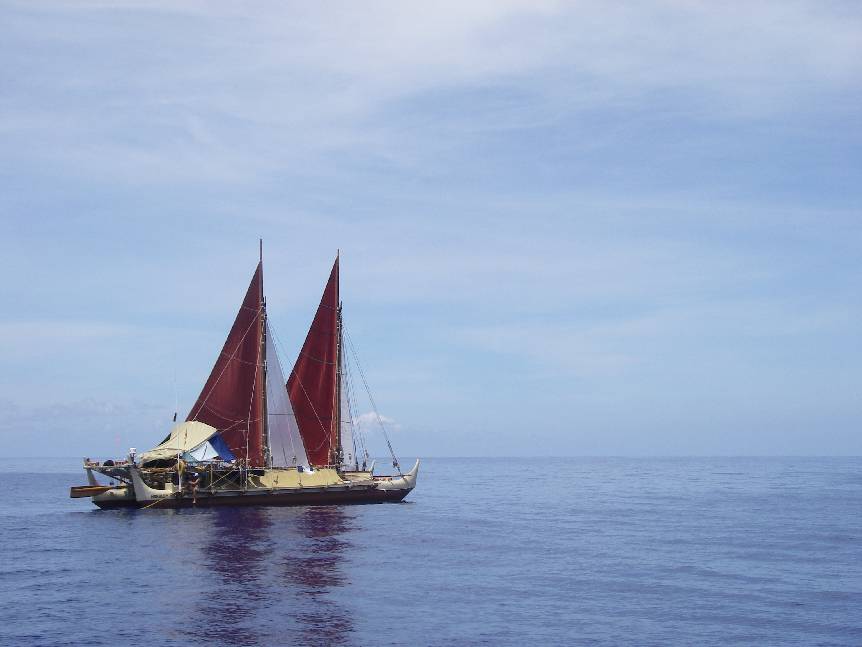
Sailing in Light Winds. Photo by Mike Taylor
Between sunrise and sunset, we traveled 21.4 nautical miles (nm) on a course of 254 degrees magnetic (W by S) and averaged 1.74 knots, but this travel only resulted in ur making 5 nm progress toward Itoman. We are 683 nm from Itoman and Yap is 478 nm behind us. We only traveled 37.4 nm in the last 24 hours.
Despite all the sails Hokule'a has deployed, there is so little wind, the crew is having to work very hard to attain even a little headway.
The weather remains good - 1/8 cloud coverage, less low cumulus and more cirrus. No precipitation during the day. Barometer steady at 30.1" or 1019 mb. Winds: variable in the eastern quadrant, currently ESE 0-3 kts. Sea state: long slow E swell 1 ft.
At 7:20 pm, our position was 16 degrees 25.64 minutes North, 134 degrees 06.89 minutes East. We were making less than one knot.
Aloha, Mike
April 18 Taku's Report
I was awaken by a wonderful rising sun. My watching shift is group A, of which Tim is the captain. I watch for 4 hours from 6 o’clock to 10 o’clock. Group B watches from 10 o’clock to 14 o’clock. And the group watches from 14 o’clock to 18 o’clock. I wash, take a bath with seawater, prepare meals and write in my diary just like I do in my normal life during my free time. Because saving individual physical strength is so important, I often lie in the bunk and take a rest. Finally, the wind began to blow yesterday. I saw the triangle of Deneb, Vega and Altair last night. And I also the α and the β that composed the Southern Cross clearly. The fair wind blew from the south all day long, and it pushed the canoe right and left. It was so hard to steer. But I had to control this canoe by myself. We navigated only with the spin sail all day that day. Nainoa , Tim and Maka had a hard time in fine-tuning. To learn the technique even a little, I helped them as much as possible. New captain, Chad Babayan, who is from the island of Hawaii, will join us after the Okinawa leg. Kana, another Japanese crew member, bears the part of sheeting line of the sails or steering with Kaiulani at the rear of the canoe. So I’m fit to support both of the watch captains. The technique of sailing is really deep. It’s difficult for big sailboats to grasp the whole thing. But it’s possible for 3 crew members to raise and lower the sails of the Hokule’a. And we can grasp the wind condition. It’s good training for me, and I’m in the best classroom and have the best teachers. This is so amazing and I am so happy!! We had a meeting with Nainoa in the evening.
He said,“The leg from Yap to Okinawa is the first and the last chance in my life. I feel very special. We determined the risk when we left Yap. We’re in about 17°North. I’m so thankful for the power of unity that holds the crew together. Every crew member has done their best. Definitely you are the best members. Thank you.”
I feel Nainoa is really great person. He always praises each crew member. He made us take more responsibility for our work. He never shouts at any of the crew for their mistakes. We are all tired in the middle of this voyage. What Nainoa said to gives energy to the inexperienced crew like me, Kana, Kaena, Maile and Dr. Pete. I suffered from seasickness many times. I thought it was because the ocean was so rough. But it wasn’t. People’s physical condition has a rhythm just like waves. I noticed that how you awake in the morning decides everything for the rest of the day. What the leader said to me supports me. Nainoa’s leadership always keeps harmony on the canoe.
The wind changed around the end of the meeting. Night came on. We had a class for students of the Kadena Air Base by using the satellite phone. One of the students asked me, “What is happy for you in the ocean?” I answered, “It’s a lot of time for thinking.” I got a definite inspiration from that question. I’ve felt how busy I have been lately. I took it as a matter of course. I noticed that I’ve forgotten what is important to myself. Up until that point, I was spending time very busily—it was like being rolled in a big whirlpool. Thanks to my time on the ocean, I can feel my wavelength every morning with winds, and waves swinging. If this situation would continue, how happy I would be!
I could feel my life plan has been achieved little by little. That is what “way finding” is all about!!
Taku
April 19 the wind has returned! flying by the latitude of Hawai'i in chilly wind
It’s another beautiful afternoon out here surrounded by dancing deep blue water and cotton-like clouds following the path of the wind across a light blue sky. Yes, the wind has returned! And so have the swells, from the north, northeast and southeast.
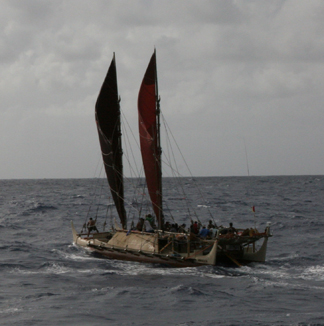
Sailing in brisker winds. Photo by Kanako Uchino
Yesterday we sailed through our first squall since we left Yap a week ago. The band of unwelcoming gray clouds on the horizon grew higher and higher until it completely swallowed the sky. It came from the end of a cold front associated to a strong low pressure system to the north of us. Once we got through it the wind intensified and switched from southwest to north northeast.
Hokule’a led us on a northwesterly course without us steering throughout the night. We were moving fast, averaging a solid 8 knots.
Hokupa’a (North Star) continues to get higher above the horizon and a few of the south stars we use to estimate latitude have already sunk below the sea. Tonight we will most likely pass 21 degrees north, flying by the latitude of Hawai’i. It has been a while since we’ve been this far north, and we are reminded by the chilly wind and colder water. Mahalo for the good thoughts and hopes for good weather, we’ve been blessed!
Malama pono,
Ka’iulani
Crew Mana'o (Thoughts)

From left to right, front row: Takuji Araki of Okinawa, apprentice navigator Ka'iulani Murphy, captain and navigator Nainoa Thompson, first mate Chadd Paishon of Kamuela, Kanako Uchino of Japan, Pomai Bertelmann of Kamuela, Atwood Makanani of Maui, back row: Kaina Holomalia of Nanakuli, Dr. Pete Roney the on-board doctor, Maile Neff of Kaua'i, who can barely be seen, and Timothy Gilliom of Maui.
Here are crew mana'o for this voyage, for the weblog.
Chadd Paishon, first mate from Waimea, Hawai’i: This is more than just about the physical aspect of tangible things, this voyage has given us the chance to reflect on things that are deeper than physically sailing across a body of water. It has given us time to ponder the deeper meaning of the canoe and of ourselves as Hawaiian People, and as native people of Okinawa and Japan. My thoughts go back to understanding my sense of place - there in lies the values that drive what I do for myself, my family and my community as I go forward. The weather has afforded us the opportunity to remember that within our past there are lessons to be learned, many of which to keep and make valuable; then there are those which we have learned from, not to be repeated again. With each mile that passes under us we are opening the door to new relationships and connections, new family and to understanding the deeper sense of working together for common purpose.
Kaina Holomalia, from Nanakuli, O’ahu: This voyage is a trip! This is my first long voyage, this is my first time out of Hawai’i, talk about good reason to leave Hawai’i. I’m used to Aloha Airlines inter-island, JAL was the biggest airplane I’ve ever been on. Crusing out in the middle of the ocean with good music, good stories, I don’t know the words to use to describe this voyage. I did plenty sails before this but there is nothing like it. The weather is crazy! All flat, cannot see where the sky begins and the water ends, the sunsets, mean. I’m learning plenty about navigation and the stars. Learning plenty about patience something that is helpful to me in my life, this has opened up a lot of opportunities for me. I’ve had job offers, I now have a job that is directly related to the canoe, I’ve met lots of people, I’ve had offers to go to different schools. The canoe has been a good way for me to help prove to our kids on the west side that there are lots of positive opportunities out there for us to choose.
Maile Neff, from Ha’ena, Kaua’i: This is my first long voyage, and I am just so grateful for the opportunity to be here. We have a great crew. Hawai’i, O’ahu, Maui, Kaua’i, and Japan are all represented. I am learning so much everyday and I look forward to bringing my experiences home to share with the keiki at home.
To me, the most exciting thing about this voyage is that we are reestablishing connections with different cultures around the pacific who are all ‘ohana to us. We have a lot to learn and share with one another. From the brief time that I’ve spent in Micronesia and with other crew members from Japan, I realize how much that we have in common as Pacifc island people. The coolest is that we gotten to make connections with people who are actively protecting and preserving their home environments and resources. I’m excited to continue these new friendships when I get home and to implement what I’ve learned in my community.
We have our own little ‘ohana out here and we have everything we need. The winds have been really light for the last couple of days, but it’s not so bad. I know that sailing is hard work, so I hadn’t really prepared to have much free time, but I realize this is part of voyaging too. We’ve been keeping ourselves busy reading, eating, laughing, singing and sharing stories. There are definitely a lot of worse places to be in the world. I think we all realize this and we’re all enjoying our time out here together. There is no place I would rather be right now.
There are lots of times in your life when things don’t go as planned and you need to make the most of what you’ve got. Just stay positive and go with the flow. Every aspect of this voyage has been a learning experience for me. I see this whole experience as training for future voyages to come when Namahoe, Kaua’i’s voyaging canoe, can sail with Hokule’a and Makali’i to Aotearoa.
Timi Gilliom, from Wailuku, Maui: This voyage has been Unreal! It's gone into this cultural phase, i expected this to be a a regular voyage but now it seems like rejuvination of one's culture. We've had our differences (japan and hawai') but in many ways we are suffering from the same problems. I think it's cool that we are going to be retracing some of the stops of Kalakaua, it's also neat to know that he traveled by sea too. I'm looking forward to learning more about the Japanese people and their culture.
When we were in Micronesia I never expected to learn as much as i did ...one example are the kapus. when we got there and started to learn their daily practices i never expected that - i think that Japan is going to be the same way, i look forward to that.
Pomai Bertelmann, from Waimea, Hawai’i: The first person that comes to mind as i think about this sail to Okinawa is Tiger Espere. He had wanted for so long to see anyone of the canoes arrive on the shores of Japan to share and exchange the story and values of the canoe. He moved from Hawai’i to Kamakura in 1997, fortunately enough for Chadd and I, he would be living with us prior to moving. He wasn’t really sure what he would do when he got there but when he did, his plan was already laid out for him (unbeknownst to him). He would call us on occasion and tell us about how he was talking with different elders about Hokule’a and Makali’i – about the mana they carried with them and about how he felt that Japan would be a great place to build another member to add to the family. I remember when he came home in 2001 he was so excited about the connections that he had made with people who at first were his acquaintances but in time became great friends and family. Even into the last 6-8 months of his physical life he still talked about building the canoe there….unfortunately he wasn’t able to see the wa’a come to pass but his dreams do not go unfulfilled. Hokule’a makes her way to Okinawa with a crew of men and women who come from places various places on the map. Engrained within us is his wish to see a canoe reach the shores of Japan. We carry Tigers desires with us in our na’au, on this wa’a and look forward to making the connections with the family and friends that he wanted so much for us to meet.
Like Tiger, the voyage of Ku Holo Mau, to Satawal and Yap as well as Ku Holo La Komohana, Sailing to the Western Sea is about discovering how knowledge is transferred from one generation to another in all cultures around the Pacific Rim. I believe that this process of transferable knowledge is taking place all around us – it is in the way that the mother bites up and softens the food before feeding it to baby, it is in the way that we cut up our kids food before they eat it. To many times these critical acts of learning goes unrecognized and therefore, in time, looses its value within the family and then within society.
Mahalo Ke Akua for this time – thank you for giving us the fast and the slow, the rough and the tough, the tired and the sleepy…..this moments in time help us to define our individual characteristics even more fully so that the next time around we are more readily prepared.
April 22 sighting Okinawa
After a cloudy, windy night and morning, Okinawa appeared on the horizon at one o’clock this afternoon. Nainoa spotted the island during a break from the hazy fog-like conditions. We were about 15 miles away, and Hokule’a was heading right for the majestic island, without anyone helping her to steer. Everyone could feel the mana of this wa’a, and we hugged each other with tears of joy and emotions we may not ever be able to put into words.
This 11 day voyage was not an easy one, and we all knew when we left Yap the challenges we could face. We were fortunate to have been clear from any threat of hurricanes, but we did experience a wide range of weather - from zero wind, flat water and extreme heat to near gale force winds, rough seas and intense cold. It was a challenge for any navigator, with all the factors of this difficult voyage, balancing weather decisions, keeping track of days of drifting and trying to uphold schedules being made for us in Japan. Yet, Nainoa’s confidence instilled the same in each of us and we all knew he would raise Okinawa out of the sea. He could see the island before any of us could, and he knew exactly where it was since the time we left Yap. Our aloha and respect for this incredible man is immeasurable. Mahalo Nainoa, your magic is an inspiration.
Well, it’s hard to believe that we’re here, more than 6,000 miles away from Hawai’i sailing to islands that look like they could be home. For two of our crewmembers, Kanako Uchino and Takuji Araki, they are home. This is not the end of a voyage to Okinawa, but just the beginning of a journey for the people of the beautiful islands of Okinawa and Japan. We are all happy and proud to be a part of it.
A hui hou, malama pono.
Ka’iulani
April 23 arrival in Okinawa
Despite the early hour there were about 150 people to greet the vessels and crews. Everyone is doing well. They must stay on the canoe until Customs and Immigration boards at about 1pm Hawai'i time and clears their disembarkation. As soon as they do there will be a press conference.
Tonight, a group of about 100 people from Hawai'i who live in Okinawa will host the crewmembers to a dinner reception. Other activities planned include school visits, canoe tours, a workshop and a visit to the Marine Museum in Motobu, Okinawa. Hokule'a will likely depart Okinawa for Kumamoto on Friday or Saturday.
Aloha, Kathy
Track of Canoes from Yap to Okinawa and Kyushu, through the Inland Sea to Yokohama
(Oceanography Department, UH Manoa)
Map 1
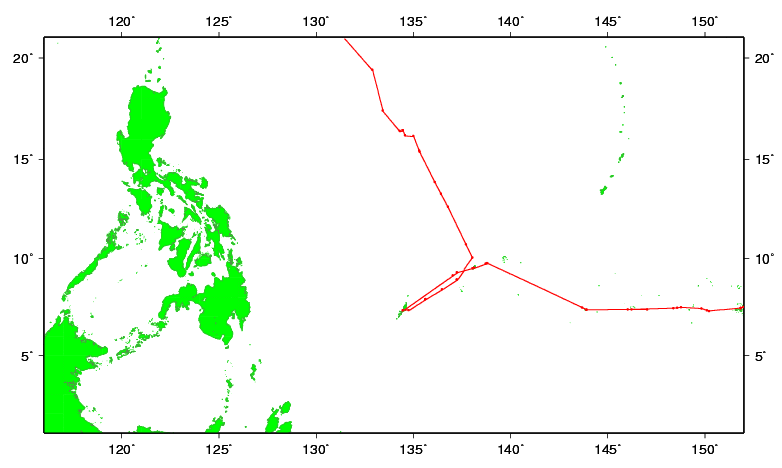
Map 2
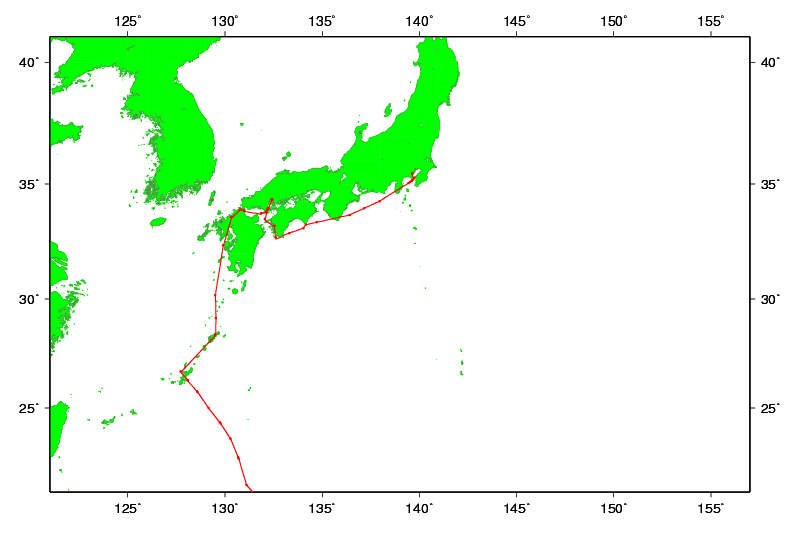
Sailing Route: Colonia, Yap [9.51333,138.12583] to Itoman Harbor, south of Naha, Okinawa [26.13240, 127.66080]
GPS fixes from Hokule'a:
- 26.13240 127.66080 04/23 06:08 am [ Itoman Harbor]
- 26.29768 128.09940 04/22 07:36 pm [Course made good 12 hrs.: 43 miles (79 km) @ 3.5 knots, bearing: 321 degrees; 10 miles off the coast of Okinawa]
- 26.28184 128.07920 04/22 06:07 pm
- 25.74407 128.59750 04/22 06:07 am [Course made good 12 hrs.: 54 miles (100 km) @ 4.5 knots, bearing: 326 degrees; 56 miles (103 km) to Itoman]
- 24.99889 129.15860 04/21 06:08 pm [Course made good 12 hrs.: 55 miles (102 km) @ 4.6 knots, bearing: 322 degrees; 106 miles (196 km) to Itoman]
- 24.27694 129.77300 04/21 06:07 am [Course made good 12 hrs.: 52 miles (96 km) @ 4.3 knots, bearing: 327 degrees; 160 miles (296 km) to Itoman]
- 23.55018 130.28660 04/20 06:08 pm [Course made good 12 hrs.: 62 miles (114 km) @ 5.2 knots, bearing: 338 degrees; 211 miles (391 km) to Itoman]
- 22.60361 130.70860 04/20 06:08 am Hokule'a [Course made good 12 hrs.: 78 miles (146 km) @ 6.6 knots, bearing: 344 degrees; 269 miles (499 km) to Itoman]
- 21.34028 131.10690 04/19 06:08 pm [Course made good 12 hrs.: 65 miles (121 km) @ 5.4 knots, bearing: 335 degrees; 344 miles (638 km) to Itoman]
- 21.34028 131.10690 04/19 06:08 pm [Course made good 12 hrs.: 91 miles (169 km) @ 7.6 knots, bearing: 307 degrees; 409 miles (758 km) to Itoman Harbor]
- 20.35028 131.59810 04/19 06:08 am
- 19.43240 132.88690 04/18 06:08 pm [Course made good 24 hrs.: 124 miles (230 km) @ 5 knots, bearing: 345 degrees; 495 miles (917 km) to Itoman]
- 19.43240 132.88690 04/18 06:07 pm
17.42806 133.42060 04/17 06:07 pm [Course made good 24 hrs.: 79 miles @ 3.3 knot average; bearing: 320 degrees; 613 miles (1136 km) to Itoman] - 16.42733 134.11483 04/16 07:20 pm
- 16.42018 134.29500 04/16 06:08 pm [Course made good 12 hrs.: 16 miles @ 1.3 knot; bearing: 336 degrees]
- 16.42018 134.29500 04/16 06:08 pm
- 16.45139 134.45640 04/16 06:07 am
- 16.20434 134.56860 04/15 06:07 pm
- 16.11696 135.00380 04/14 06:06 pm [Average speed and bearing 12 hrs.: 4 knots, 337 degrees]
- 15.38129 135.32280 04/14 06:07 am
- 13.86407 136.10360 04/13 12:41 pm
- 12.61444 136.77830 04/13 12:41 am [Course made good 24 hrs.: 172 miles @ 7 knots; bearing: 334 degrees]
- 11.22083 137.58060 04/12 12:41 pm
- 10.03129 138.03820 04/12 12:41 am
- 9.51361 138.12580 04/11 12:41 pm [Colonia, Yap]
April 24
Aloha to all:
Last night, the Hokule'a crew was greeted with great Aloha by the people of Itoman and others representing all of Okinawa. I was fortunate to be in Okinawa on behalf of the Hawaii United Okinawa Association on other matters so the timing of their arrival on early Tuesday morning was wonderful news.
Vice-Governor of Okinawa Katsuko Asato and Itoman Mayor Gayu Nishihira were in attendance to witness wonderful hula performances by an Okinawan Halau and an energetic Eisa (drumming) performance by young students in the Itoman area. As the Hokule'a and Kamahele re-entered the harbor for the ceremony, there were a few canoes and Okinawan Hari boats paddling along side.
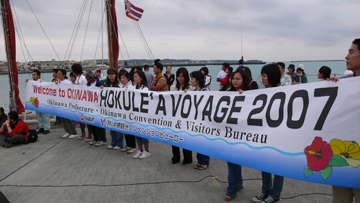
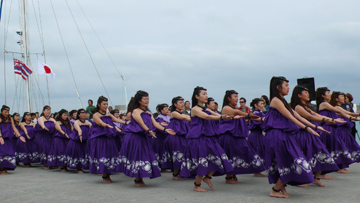

The crew greeted the harbor crowd with their own unique "haka" on the deck of the Hokule'a.
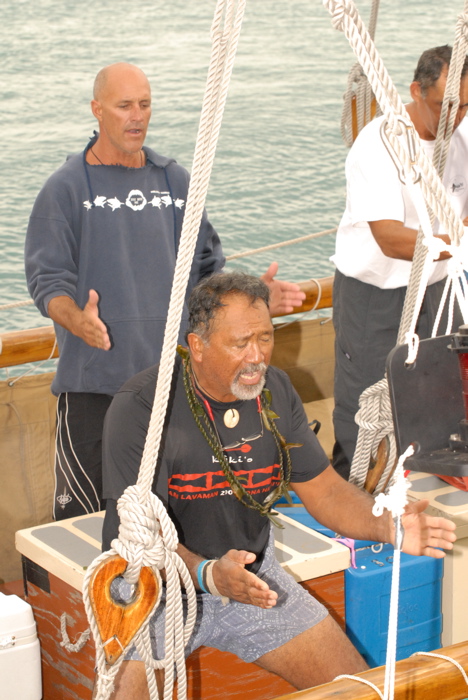
Maka leading the aiha'a.
Among others, President of the Hawaii United Okinawa Association and Nainoa's high school classmate, David Arakawa, presented a wonderful rousing speech about "Kizuna" ("bridging") that was truly represented this historic occasion. Japan and Okinawa native crew members Kanako Uchino and Taku Araki couldn't hold back their emotions as Nainoa described the challenges they both faced and overcame on the ocean and reminded everyone there that the key was to remember that Kanako and Taku were doing it for not themselves but for others.
The crew was then treated to a feast of different foods ranging from curry rice and andagi to kalua pig and ono beef and chicken teriyaki. They are scheduled to join up with a local Hawaii style pot luck Friday night at Camp Foster and attend a Luau on Saturday.
Back in January, I participated with the Young Okinawans of Hawaii, in the Okinawan Lion "Shishi" in the Hokule'a departure ceremony in Honolulu and was graciously greeted by Kana Uchino and I had hoped to see their arrival in Itoman and capture the expressions of the crew and the Okinawans for Kana. I'm glad my wish came true.
April 25 events on Okinawa
Tonight will be the official welcoming ceremony for the crews of Hokule'a and escort boat Kama Hele. This is organized by the governments of Itoman city and Okinawa prefecture. It will be held at the nearby Bibi Beach. In addition to government officials, attendees will include teachers, students, the general public, Hawai'i expatriates and members of the Hawai'i United Okinawa Association who flew to Okinawa for Hokule'a's arrival.
PVS NOTE: Here are some other events (JST) that have been proposed. But contact local organizers to confirm the schedule because it is subject to change. The Tourism and Commerce Dept. may be coordinating, or at least serving as the point of contact, for events.
April 26 (Thurs.)
9:00a.m.-12:00p.m. Workshop for high school students
1:00p.m.-3:00p.m. Workshop for general public
5:00p.m.-7:00p.m. Lecture by Nainoa to 300 audience
April 27(Fri.)
Day visit to Okinawa Marine Expo and Kadena Air Base, followed by a reception at Kadena
April 28(Sat.)
9:00a.m. Blessing ceremony for safe voyage
10:00a.m.-11:00a.m. Departure ceremony
April 23-29: on Okinawa
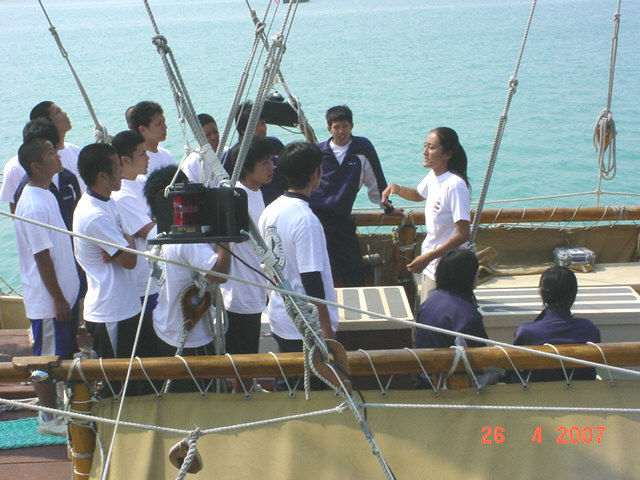
Kana talking with visitng students
E na ohana, na hoa kako’o, a me na hoa hou mai o a o o ka honua nei, Aloha mai kakou.
Family, friends, and new friends, greetings of aloha to us all.
Eia mai makou ma ka ‘aina o Iapana, ma ka mokupuni o Okinawa. Ua ho’okipa ‘olu’olu ‘ia mai makou me he ‘ohana la, mai ka pae ‘ana o ka wa’a ma Itoman, a i ka ha’alele ‘ana aku no Iapana no. He ‘aina ‘olu’olu keia ‘aina, a ua ‘ano like ke anila me ko Hawai’i, koe na’e ka hu’ihu’i iki a’e. He mea ‘ole ka hu’ihu’i o ka makani, i ka mehana o ke aloha o ka po’e. I ka pae ‘ana o ka wa’a, ua hula mai he halau hula kepani, a laila ua hulahula kekahi hui hulahula pahu taiko. Kahaha ho’i ka u’i o na loina ‘oiwi Okinawa.
Here we are in Japan, on the island of Okinawa. Here we were greeted as ‘ohana, from the time we landed, until the time we set sail again for Japan proper. The weather here, although a bit rainy, was similar to Hawai’i, all be it a good bit colder. The cold however, was overwhelmed by the warmth and graciousness of the people of Okinawa. We were greeted with hula from a local hula halau, and with some awesome taiko drum dancing. The bit of their culture that they shared was just amazing.
No na la pokole i noho makou ma ka ‘aina, ua nui na hanana i ‘ike ‘ia. Ua malama ‘ia he pa’ina ma ka po mua, ua ha’i ‘olelo na kapena ma ke kula lawai’a, (‘oiai he mea nui ka lawai’a ma keia mokupuni), ua ho’okipa ‘ia na keiki, a me na po’e kaiaiulu, ua kipa makou i ka Ocean Expo Center, ma laila he ho’ike’ike nui no na wa’a o ka pakipika, ua hookipa ‘ia makou ma ka ‘aina pu’alikoa o Camp Foster e na ‘ohana Hawai’i e noho ana ma laila, ua malama ‘ia ka ‘aha ‘aina ka hale ‘o Sam’s, e ke hoa hou ‘o Wyatt, ua malama ‘ia he pule ho’omana ‘oiwi ma kekahi ahu, a laila, ‘o ka hanana hope, he ‘aha no ka ho’ouna ‘ana aku ia makou me ka palekana.
The few short days spent on land were filled with events and presentations. There was a welcoming reception, presentations given by our captains and local Japanese crew members at the local fisheries high school (fishing is a large part of the culture here), a couple of hundred school children and community members visited the canoe, we visited the canoe museum display at the Ocean Expo Center, we were hosted for a party and presentation at Camp Foster with the Hawai’i military families and local Hawai’i ex-patriots, we were hosted for a dinner at Sams by the owner Wyatt, a temple ceremony was held praying for a safe journey [Hakugindo], and lastly a farewell ceremony was given near at a fish warehouse near the canoe.
I loko o na hana nui ma waho, ua nui na hana e koe ana ma ka wa’a. Ua ko no na hana ma ka wa’a me ke kokua nui ‘ia e na ‘ohana no Hawai’i e noho ana ma Okinawa nei. He ‘oia’i’o no ka ‘olelo a na kupuna “ ‘a’ohe hana nui ke ‘alu like ‘ia”. No laila makou e waiho nei i ka ‘olelo mahalo…
In spite of the large amount of work with the community off the canoe, there was an even larger work load on the canoe to prep for departure. This large amount of work was successfully completed with the help or our new found ‘ohana and friends. It is true what our kupuna say, “ there is no work impossible when done together.
I keia kakahika(LP), ua hui makou ma ka wa’a, ma ka hola 6 kak. no ka ho’omakaukau ‘ana no ka ha’alele. Ua hele nui mai ka po’e e aloha aku ia makou. Ma hope o ka pule me ke oli ‘ana, ua ho’oku’u i na kaula uapo mua, kau ‘ia ka pe’a ihu, a laila ka pe’a hope, a ua holo aku ka wa’a. Ikaika kupono no ka makani, a ua holo. I keia Manawa, ke holo nei i ka ‘akau… Me ke aloha no e ko Okinawa e…
This morning (Sun.) we gathered at the dock at 6a for an 8a departure. There we were greeted by our new Okinawa families. After we shared in a prayer, and an oli, we let loose the forward docking line, raised the forward sail the aft, and we sailed away from the dock for open sea. The wind is good, and we are off to the north to continue on to our next destination, hailing our aloha for those we left in Okinawa.
April 28: plans for depature
Weather permitting, Hokule'a will depart Okinawa tomorrow, Saturday Hawai'i time. Chad Baybayan is the captain and navigator of Hokule'a while Mike Taylor continues as captain of Kama Hele. This leg of the voyage will take them to Kumamoto, Nagasaki and Fukuoka, where there will be another major crew change.
The journey from Okinawa to Kumamoto is about 455 miles and should take about 6 days or so. The canoe will dock at Uto Marina, on Uto Peninsula southwest of Kumamoto City.
A special mahalo to the Yap-Okinawa crew that returned home. You will be missed, and we will take your aloha on with us…Departing Crew: Nainoa Thompson, Captain; Chadd Paishon; Pomai Bertlemann; Kaina Holomalia; Maile Neff; Dr. Pete Roney
Staying On: Atwood (Uncle Maka) Makanani; Timothy (Timitete) Gilliom; Ka’iulani Murphy; Taku Araki; Kanako Uchino
New Crew, with Bios:
Kalepa Baybayan- Captain, navigator, crewmember, PVS coordinator/planner, first voyage in 1980. Currently, captain of Hokualaka`i, Voyaging curriculum developer and project Director for the He Lani Program of the `Aha Punana Leo. Just recently initiated in to the highest level of Navigation in the tradition of Satawal. The pwo ceremony conducted by Mau Pialug initiating Nainoa, Bruce, Shorty, Kalepa, Chadd, and Sesario.
Ka`iu Kimura- Experience coordinator of the `Imiloa Astronomy Center. Many hats as a Hawaiian language instructor, coordinator, and curriculum developer with the `Aha Punana Leo and Ka Haka `Ula o Ke`elikolani.
Kaimana Barcarse- Director of the Media Division of the `Aha Punana Leo; Culture and Language Instructor at Ka Haka `Ula o Ke`elikolani, UH-Hilo; Coordinator and DJ for Hawaiian Language radio show, Alana i Kai Hikina. Is currently a Crew member and Watch Captain with Hokualaka`i and Kea`eloa and has been with Hokualaka`i project from its inception in 1999.
Ah Lun Yung- Works with the He Lani Program of the `Aha Punana Leo under Kalepa. He is the crew coordinator, and on-site voyaging coordinator for Hokualaka`i and Kea`eloa. Retired from HELCO, Ah Lun brings multi-level organizational and technical skills to the project. He has been with the Hokualaka`i project since 2004. And experienced his first inter-island sail on Hokule`a in May of 1977.
Mona Shintani- A native of Ni`ihau and a manaleo, with Hawaiian being his first and primary language. He is also the nephew of Elia “Kawika” Kapahulehua, one of the original captains of Hokule`a. Along with his language and cultural background, Mona brings hana lima (hands on) skills to the project. Mona has been with the Hokualaka`i program since 2001, and experienced his first sail on Hokule`a in 1999 from Nukuhiwa to Mangareva.
Maka`ala Rawlins- As a `Aha Punana Leo employee, he works with the Lamaku scholarship program as a scholarship counselor, community coordinator as well as a community service manager. As a crewmember on the Hokualaka`i, `Aha Punana Leoʻs educational deep-sea traditional voyaging canoe, he has been apart of many different sails within the state of Hawai`i from Kaua`i to Hawai`i island. He is also a Hawaiian language speaker as well as a Lecturer at UH-Hilo.
Mr. Oku- A colleague of Captain Amemiyaʻs, Japan Voyaging Training School. He was born in 1966, graduated from Tokyo University of Mercantile Marine in 1992 and joined Japan voyaging training school. Captain Amemiya negotiated with Japan Voyaging Training School to make him available for Okinawa-Kumamoto to secure safe voyage in the leg. He is one year older than Captain Kono, but it takes time to go up ranking at the Japan Voyaging Training School, which is a public sector, and he has been serving as first officer for over 10 years.
Melvin Lilikala Paoa- Of Moloka`i will serve as the medical specialist on board Hokule’a. A veteran deep-sea sailor, He has sailed aboard canoes since 1975. He is and Emergency Medical Technician on the island of Moloka`i where her resides with his wife Donna.
Pa`ana`akala Baybayan- 23 years old daughter of Captain-Navigator Chad Kalepa Baybayan, a graduate of Kealakehe High schools first graduating class in 2001, “Kala” attends Maui community College where she studies Hawaiian language, she is an avid surfer who studies traditional wayfinding-navigation from her father.
Notes on Hakugindo, a four-hundred year old shrine, where the crew went to pray for safety at sea before departing Okinawa:
Hakugindo a shrine tucked alongside a highway just south of the Itoman City, attracts thousands of visitors each year who take time to stop, ponder the legend of two men whose paths crossed four centuries ago, and ultimately led to wisdom and peace: a poor fisherman borrowed money from the samurai to buy a fishing boat, nets and tools. When the samurai returned to collect his loan, the catches had been poor and the fisherman had no money to pay. The samurai became angry and drew his sword. The fisherman admonished the samurai to learn to calm his anger. The samurai did calm down and returned home, where he found a man's footwear in front of his door. Thinking his wife was sleeping with another man, he became angry and drew his sword, but remembering the fisherman's words and calmed down. He realized the person in the house was his mother, who was dressed like a man in order to protect her daughter-in-law from intruders when her son was away. When the samurai went back to the fishherman a year later, the fisherman had the money to pay him back. However, the samurai felt that since he had learned a lesson about controlling his temper from the fisherman, he no longer wanted his money back. Nor did the fisherman. So the two buried the money in a cave, and built a shrine on top of it. The shrine became a place for prayers for the safety of fishing and fisherman.

Hakugindo. Photo by Gary Goya
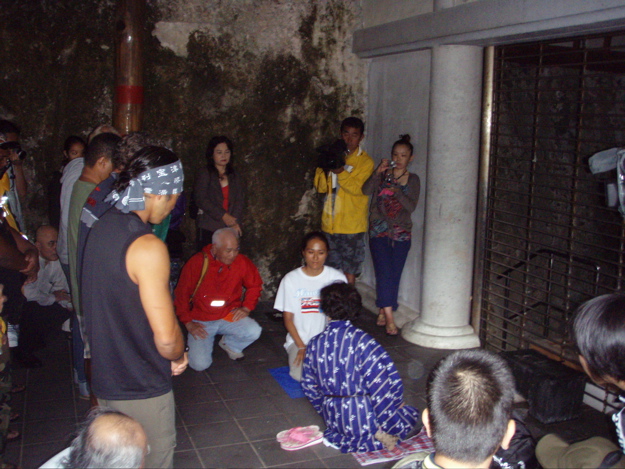 '
'
Prayer for Safety.
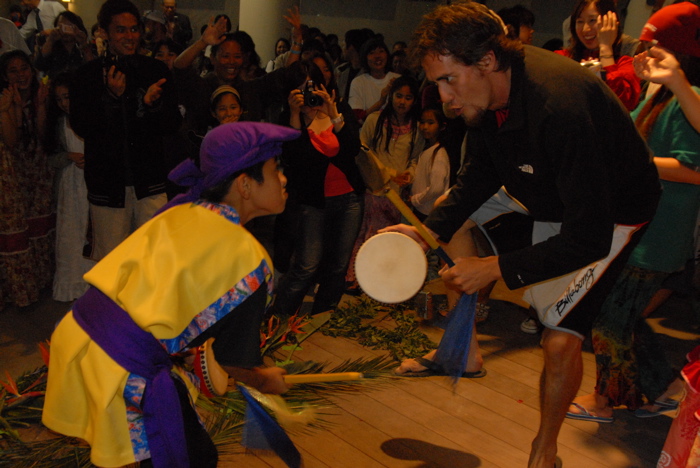
Crew member Maka'ala Yates drums and dances.
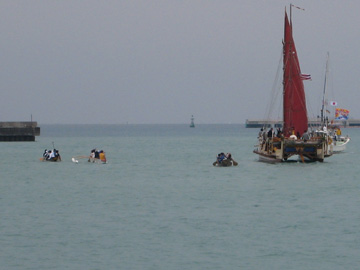
Leaving Itoman Harbor. Photo by Gwen Fred

Kaimana and Ka‘iulani, departing Itoman Harbor.
April 29-30 Okinawa to Amami
Ua ha’alele makou ia Itoman, Okinawa i ke kakahiaka o ka lapule, ka la 29 o ‘Apelila. Ua huki ‘ia ka wa’a i ka ‘akau a i kahi i hui ai makou me kekahi moku no Yanmar – he ‘oihana hana ‘enekini no na moku. Ua makana ‘ia ‘o Ho
We left Itoman, Okinawa on the morning of Sunday April 29. We towed up the coast for about an hour, where we were greeted by representatives from the Yanmar boating company. They presented us with gifts and took photos and sent us off on our way.
Ua ho’oholo ‘ia ka holo ‘ana i Amami-no-shima – he mokupuni li’ili’i i ka ‘akau o Okinawa, he 120 mile ka loa – i kaulana i ka po’e lawai’a (Amami – he i’oa; no – o; shima – mokupuni). Ua ‘ike ‘ia ka holo ‘ana mai o kekahi ‘ino a no ia kumu i ho’oholo ai ke kapena ‘o Kalepa i ke ku ‘ana ma ia mokupuni a hala ka ‘ino no ka ho’omau ‘ana a’e i Kumamoto, Iapana. Ua anuanu ke kai, a ua pa mai ka makani mai ka ‘akau hikina a ua pihoihoi na holokai i ka holo ‘ana ma ka moana.
The sail plan for this day was to get to Amami-no-shima - an island about 120 miles north of Okinawa – where we would dock for the night in anticipation of a passing storm. The seas were cold with a nice steady wind blowing from the northeast and all of the crewmembers were excited to be on the ocean again.
Ma ia po, ua anuanu a pulu ka wa’a a ua lohi loa ka holo ‘ana o ka manawa. Ho’oka’awale ‘ia na holokai ma ‘elua pu’ulu. Malama kekahi pu’ulu i ka wa’a no ‘eono hola, a laila kuapo na pu’ulu ma ka pau ‘ana o ia mau hola. Ua maka’ala na holokai i na moku ‘e a’e e holo ana ‘oiai he ‘ano “alahele” nui o ka holo ‘ia keia. Ua ka’alo no kekahi mau moku nui ma ia po.
The evening time went by slowly in the cold, gusty breeze and slight sprays of ocean splashing on deck. The crewmembers were divided into two watches - each watch being six hours long. All were on the look out for passing freighters and fishing boats as Höküle’a sailed through a frequented shipping lane. A few had passed by throughout the night.
I ke ao ‘ana a’e o ka po, ua hui na holokai a pau no ka wa ‘ohana. Ua pule, a oli makou ia Ia Wa’a Nui. Ua ho’ike pu mai ‘o Kapena Kalepa i kona mahalo i ke alulike ‘ana o makou i ko na hana a pau me ka maika’i. Ua ho’ike pu ‘ia mai ka pae ‘ana i Amami-no-shima a me ko makou noho ‘ana i ia mokupuni a hala ka ‘ino i wanana ‘ia.
As morning rolled around, the crew gathered together for our ‘ohana time – a time for everyone to share thoughts, reflect, offer prayers of thanks and for continued safety, and song. Captain Kalepa Baybayan expressed his mahalo to the crew for working well together and supporting one another. He also shared the plan for the arrival in Amami-no-shima, an island that is famous for it’s fishing communities.
Ua ho’ea i ka mokupuni ma mua o ka ‘ike ‘ia o ka ‘ino. Ua pae i ke ahiahi o ka po’akahi, i ka la 30 o ‘Apelila. Ua holo mai 2 moku lawai’a i mea e kokua ai ma ka ho’okele ‘ana i loko o ke awa. He ‘aina nani keia e noho ana i ka palekana o ke awa i kai o kekahi awaawa nui. Ua ‘ike ‘ia na kaona li’ili’i e waiho ana ma na hono li’ili’i o ua ‘aina nei. Ua ho’opa’a ‘ia ka wa’a i ka uapo a ua pa’ina ahiahi na holokai ma luna o Hokule’a.
We made good time in getting to the island as we arrived before stormy weather came our way. We arrived on the evening of Monday, April 30. Two fishing boats greeted us outside the harbor and guided us safely into their protected harbor that lays at the bottom of a large valley with numerous fishing communities tucked away in small bays. We secured Hokule’a to the pier and had dinner on board.
Mahalo nui i ka holokai ‘o Taku Araki, nana ho’i i ho’onohonoho he wahi e noho ai makou no ia po. Ua noho i kekahi halau karate a ua malama maika’i ‘ia e ka po’e no ia wahi – ua hamama na ‘ipuka no ko makou ‘au’au ‘ana a ua launa ho’i me makou i ka ‘olu’olu o ko lakou mau wahi home. Ua hau’oli loa makou i ka malo’o, a i ka mehana ho’i o ia mau hale!
Crewmember Taku Araki arranged for us to stay at a karate dojo. The local people were very hospitable in opening up their homes for crew to shower and hung out with the crew for the evening. It was nice to have a warm shower and a dry, cozy place to have a sleep!
Ia makou e kali ana i ka hala ‘ana o ia ‘ino, e ho’omau ana i ka hana ho’oma’ema’e a ho’oponopono ho’i ia Hokule’a me ke ‘ike pu ‘ana i ka nani o ia mokupuni nei ‘o Amami-no-shima.
As we await the passing of the storm, the crew continues to do minor cleaning and preparations on board Hokule’a as well as experience the beautiful island of Amami-no-shima, its people and culture.
na'u no,
na Ka'iu Kimura
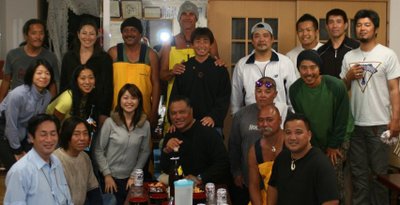
Welcome party at Master Miura’s Karate Dojo. The crew with Miura, who is at the left end of the front row.
April 30
Honolulu, HI - Hokule’a and the escort boat Kama Hele will wait out a storm at the Japanese Coast Guard port in Amami Island. Hokule’a left Okinawa Saturday afternoon, Hawai’i time, and its captain and navigator Chad Baybayan decided to pull into Amami 24 hours later. The storm is forecast to bring gale force winds and thunderstorms tonight.
Polynesian Voyaging Society president Nainoa Thompson says “I’m very proud of Chad for making all the right leadership choices to get Hokule’a through this area of potentially dangerous storms. Amami Island is the only truly safe anchorage in the area to hide from Japan’s subtropical low pressure storms. They made the choice to go to Amami before the storm, sit there for the storm to go by then they’ll only be two days away from reaching Kumamoto. So it was a good leadership choice to split the sail and use Amami as a safety port. There are 3 to 4 days of good weather forecasted behind this storm, before the next storm approaches.”
Baybayan says all crewmembers are well, safe and warm. He says the people of Amami are extremely hospitable. They are putting up the crew at a karate dojo for the night. Pending weather, Hokule’a and Kama Hele will depart Amami at dawn tomorrow, Japan time, which would be about 10:30am, Hawai’i time.
May 1
Crewmembers of Hokule’a were supported by the well-known traditional canoe builder Mr. Tsuboyama Ryoichi and his friends. Tsuboyama family is the last traditional canoe builder in Amami. But He recently developed new style of Amami’s traditional canoe with Professor Hattori of Kagoshima University. The new canoe design is based on Amami’s traditional fishing canoe “Itatsuke” and uses Sugi wood of Kagoshima. The canoe named “Kukkaru”. “Kukkaru” means Ruddy Kingfisher. “Kukkaru” can be used as a fishing boat or recreational canoe.
Mr.Tsuboyama and Prof. Hattori hope that “Kukkaru” will be the breakthrough of the Amami’s traditional canoe culture. They want to preserve the rich tradition of Amami’s canoe building and paddling culture.
Kato Kosei
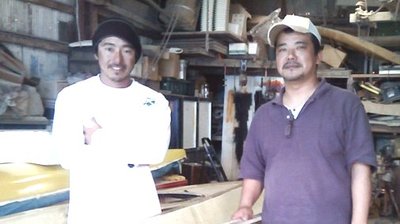
Araki Taku, Hokule'a crew member, and Tsuboyama Ryoichi, a master traditional canoe builder in Amami

Chad with Tsuboyama
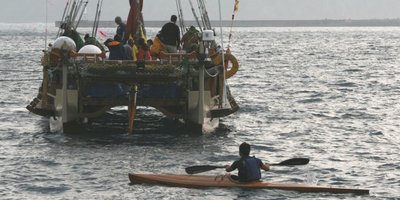
Tsuboyama-san and friends escorted Hokule'a by wooden sea-kayak and Ainoko (Amami's traditional fishing canoe).
(Photos from the website of Mr. Tsuboyama, the master traditional canoe builder of Amami: http://scofits.mo-blog.jp/ayhavela/2007/05/post_c9ff.html)

Amami departure. Photo by Tomohiro Aoki
May 2-4 Amami to Kumamoto
To our elders, our familias, our children, and to all who support this voyaging tradition, our aloha to us all…
Eia mai makou ma kai hohonu e pi’i ana i ka ‘akau, i Kumamoto. I nehinei, kakahiaka nui makou i ha’alele ai i ka mokupuni o Amami. Ua ku mua makou i laila e kali ai i kahi ino e ma’alo ana i ka ‘akau o makou. Ia makou i ma ka ‘aina, ua ‘ike hou ‘ia ka nani o ia ‘aina o Iapana, me ka ‘olu’olu palena ‘ole o ka po’e. I loko no o ka hiki ‘ole ke kama’ilio ma ka ‘olelo ho’okahi, ua hiki no ke ho’oka’a’ike ma o ka mino’aka me ke kuhi lima, a no ia kumu makou i kuhi ai he ‘oi loa a’e ke ‘olelo Hawai’i makou i ka po’e Kepani ia makou e ho’oka’a’ike ‘ana ma o na kuhi lima. Ua maika’i.
Here we are, on the deep waters again, making good progress northward for our next destination of Kumamoto. Yesterday we left port at Amami where we stopped to wait for a low pressure system to pass ahead of us. On land we again witnessed the beauty of Japan and the hospitality of its people. Although we could not communicate directly through a single verbal language, much communication was achieved with hand gestures and a smile. With that in mind, most of us spoke Hawaiian in our efforts to communicate with non-english speaking Japanese friends. It was great.
Ma kahi a makou e holo nei i keia Manawa, ua nui ‘ino na moku halihali e holo pu ana ma ke kai ho’okahi. ‘O keia na moku e lawe ana i na pono kalepa mai Kina, Iapana, Taiwán, a pela hou aku. No ia kumu he pono ka ‘o’ole’a ma ka maka’ala ‘ana no na moku e a’e ma ke kai. I ka po nei, ua kipa mai he hoa i ka wa’a nei. He manu li’ili’i ‘ia, he ‘ano tern ‘o ia i ‘ike ‘ole ‘ia ma Hawai’i aku. Ua moe ma ka wa’a no ka po holo’oko’a, a laila, ma ke kakahiaka nui, ma kahi o ka wa i pi’i ai ka la, ma hope pono o ka malama ‘ia o ka piko, ua lele aku ua manu li’ili’i la.
Where we are passing through at this time, is a very busy traffick lane transporting goods back and forth between Japan, Taiwan, China, and the west. That is why we need to be extra diligent on our watches as we are but specks of sand compared to these mega-shippers. Last nite in the midst of our ship spotting efforts, we were visited by a little tern like bird,(One not found in Hawai’i) who stayed with us till morning, till just after we had our morning opening of the day, then it took flight.
Ua hopu kekahi ahi la-uliuli nui i ka makau ma kea ho lawai’a, aka ua ku’u… Ua nui no ia ahí, ua huki ‘ia a pololei ka makau i makana ‘ia e Tokunaga ma. Ua ho’i no i ke kai o Kanaloa, o kekahi a’e, no makou no ia.
Ua noi mai na hoa holokai e aloha aku i na ‘ohana me na hoa ma ka ‘aina i ‘ike ‘oukou, he maika’i wale ka makou, maika’i ke ola kino, maika’i ka na’au, maika’i ka ‘uhane, ua nui ka ha’oha’o i na ‘ohana, aka ua ‘ike pu ‘ia ka nui aloha i ka ho’oku’u ‘ana ia makou e hana ai i keia hana.
A large bluefin tuna teased us a bit by hitting the lure gifted to us by Tokunaga, and it bent one of the hooks straight. That one returened to Kanaloa, the next one is for us maybe?
Our ‘ohana here on the wa’a wants to express our aloha to our families at home, and to let you know that all is well in mind, body, and spirit. And although we are missing you, our loved ones, your aloha is felt daily, and so is your support for our journey.
Me ke aloha pau ‘ole…
na Kaimana
Uto, Kumamoto
Everything went well and we made good time to Kumamoto, on the island of Kyushu.
I ka ho’ea ‘ana mai i ke kai ma waho pono o Kumamoto, ua ho’okipa mua ‘ia makou e kekahi ‘au moku lawai’a, he kanakolu paha ka nui. Ua ka’i like makou i ka uapo, kahi i pa’a ka wa’a no keia wa pokole ma Kumamoto nei. Ma ka uapo ua malama makou i ka pule, ua oli ‘ia ke oli ‘o Ia Wa’a Nui, a ua hana ‘ia ka ‘aiha’a Hokule’a. A i ka ha’alele ‘ana i ka wa’a ua hula mai na wahine i kekahi mau mele Hawai’i le’ale’a.
As we arrived just outside of the Uto port at Kumamoto, we were greeted and escorted by the local fishing fleet, whose numbers topped 30. They traveled with us in to the dock, where Hokule’a was to be moored. After tying off and securing the wa’a, we held our end of leg prayers, chanted Ia Wa’a Nui, and preformed the Hokule’a ‘aiha’a. In return we were greeted with Hawaiian music and hula dancing.
Ke noho nei makou ma kekahi hale B&B kaila kahiko. Moe makou ma luna o na futon i hali’i ‘ia ma luna o na moena tatami. O ke kapu ‘au’au he furo ia. A hanai ‘ia makou ma ke kaila kepani ma’amau. Keu a ka maika’i ka ‘ike maka ‘ana i ka nohona Kepani.
For this port call, we are being housed in a traditional Japanese house converted to B&B. We sleep on futons, laid on tatami mats. For bathing, we go to bath houses or bathe in the furo at the house. We are also fed many traditional foods. It is awesome to witness first hand the beauty of the Japanese culture.
No ‘elua la, ua malama ‘ia na pu’ulu ho’okipa wa’a, a hele mai ka po’e ma na haneli! Kalaiwa kekahi mau po’e he 3 la no ka ‘ike maka ‘ana i ka wa’a. Kupaianaha ka nui aloha o ka po’e ia Hokule’a. Ma ka la mua, ua nui ka hana ho’omakaukau no ke kipa ‘ana o ka po’e i ka wa’a, a laila ma ka pau ‘ana o ka la, ua lawe ‘ia makou i ka hale ali’i ‘o Kumamoto. Ma hope mail, ua hanai ‘ia makou ma ke kaila pa’ina i kapa ‘ia ‘o “Izakaya”, me ke Karaoke pu ma hope. He la piha loa ia. Ma kekakahiaka o ka la ‘elua, ua lawe ‘ia makou ma na moku lawai’a e ‘ike maka ai i ke kaila o ko lakou lawai’a muhe’e ‘ana, a laila ua ka’i pu makou ma ka paikau moku. A o ka hanana hope o ka la, he ho’olaule’a e ho’okipa kuhelu ‘ana ia makou. Nui ‘olu’olu keia po’e I ka malama ‘ana ia makou.
For two days we are conducting canoe tours,and the people are turning out by the hundreds. Some have even driven 3 days to be here and see the canoe first hand. The first full day was filled with preparation for the tours and the many activities planned. Once the tours were done, we visited Kumamoto castle, and partook in Japanese, craze called izakaya (heavy pupu hour ho’i!) followed by some Karaoke. It was another very full day. On the second day we woke early to be taken on their fishing boats to witness their ika(squid/cuttle fish) fishing styles, and then we participated in a boat parade. The last event of the day is a welcoming ceremony to officially welcome us to Kumamoto. The people here are amazing in their hospitality and aloha.
I ke kakahiaka ‘apopo, e ha’alele ana makou ia Uto, Kumamoto no Nagasaki, me ke ku ‘ana ma kekahi ko’a lawai’a Kepani ia makou e pi’i ana i ka ‘akau.
Tomorrow morning we leave Kumamoto for Nagasaki, stopping at a fishing shrine on the way.
Nui ka hana, piha i ke aloha.
A lot of work, but filled with aloha.
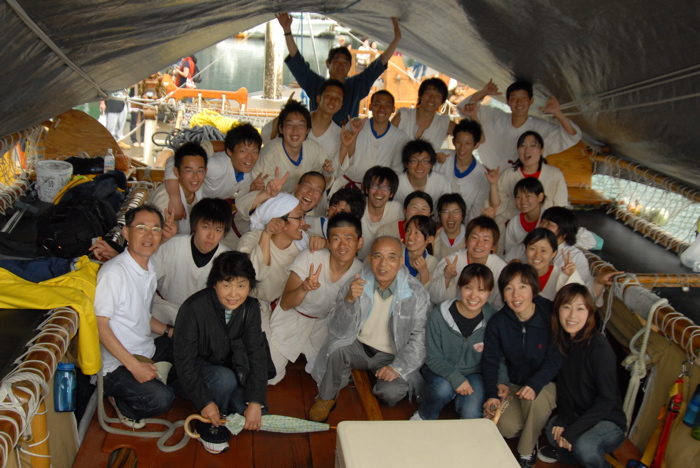
Canoe Tour. Photo by Kaimana Barcarse
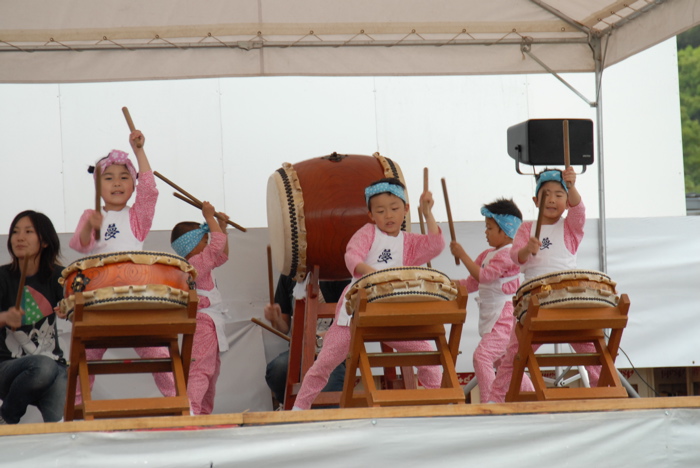
Taiko Kids. Photo by Kaimana Barcarse
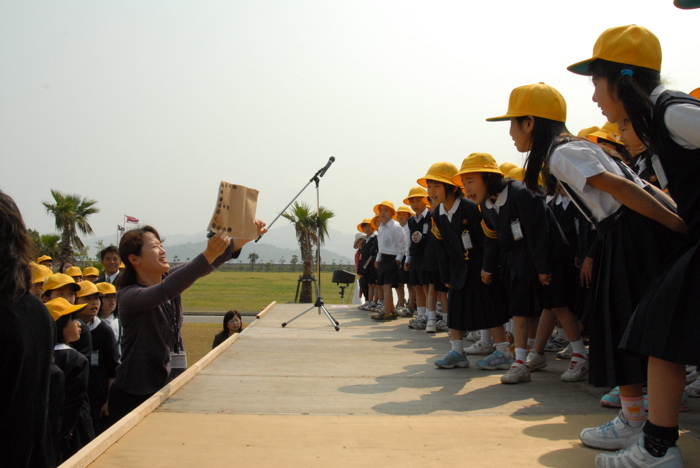
School children reading letter in kanji, from Hawai'i. Photo by Kaimana Barcarse
May 6-7 departing from Uto for Nomozaki and Nagasaki
6 Mei 2007 – Ua malama ‘ia he ‘aha ho’okipa no na holokai o Hokule’a me Kamahele. Ma ia ‘aha ua aloha ‘ia na holokai a me ka mana’onui o ko Hokule’a holo ‘ana i Iapana ma e ka meia o Uto – he mahele ia o ka moku ‘o Kumamoto – a me na la
6 May 2007 - The mayor of Uto and many representatives from the community hosted a welcome ceremony and dinner for both crews of Hokule’a and Kamahele. At the ceremony – following a parade of boats – the Mayor and other government officials addressed the crew and the overall vision and purpose of Hokule’a’s travels to Japan. Song and dance were a part of the festivities. Children, about 4-6 years of age stole the hearts of the crowd on their Taiko drums, an intermediate school-aged children band performed, and women dancing “nihonbuyo” – an old style of Japanese dance – were all a part of the entertainment for the evening. After the festivities and dinner, the crew returned to the hostel to rest and prepare for departure the following day.
7 Mei 2007 – Ua akoakoa na holokai i ke kakahiaka nui ma Uto Marina – mai laila aku e ho’omau ai ‘o Hokule’a no kona wahi hou e pae aku ai. Ua akoakoa hou ka po’e he nui e aloha aku ai i ka wa’a me ka mahalo ‘ana aku i kona ku ‘ana ma ko lakou ‘aina ‘o Kumamoto. Nui na haumana o ke kula ha’aha’a i akoakoa me ka himeni pu ‘ana. A ua ho’ike hou mai ka meia i kona mahalo a me kona mana’olana e ho’omau ‘o Hokule’a me ka palekana. Ua ho’ike pu ‘o Kapena Kalepa i kona mahalo i na kanaka ho’olala, na ‘ohana i kako’o nui mai, a me ko ke kaona a pau no ka malama a ho’okipa maika’i ‘ana i na holokai ia makou i noho ai i Kumamoto.
7 May 2007 – The crew gathered at Uto Marina where a departure ceremony was held to bid all a farewell and safe travels for the remainder of the journey. School aged-children from preschool to middle school shared in song and dance. The Mayor also gave a final address as well as Captain Kalepa Baybayan – expressing the crew’s heart-felt appreciation for all the warm hospitality that was given during their stay in Kumamoto prefecture.
Ua ha’awi ‘ia he leka i kakau ‘ia e na haumana o ke kula ho’olu’u ‘olelo ‘o Nawahiokalani’opu’u. Ua haku ‘ia keia leka me ka ho’ohana ‘ana i na hua kina. Ua ho’ouna ‘ia ka leka me na holokai no Hilo me ke aloha ‘ana aku i na mauna, na kai, ka po’e a me na kupuna o ia wahi ‘aina nei ‘o Iapana ho’i. Nui na mamo a na kupuna kepani, pake, kolea, a okinawa ho’i he mau haumana lakou ma Nawahi. A no ka ho’ohanohano ‘ana i ia mo’aukala o ua po’e haumana a me ka mo’aukala o Hawai’i me Asia ma, ke a’o nei na haumana i ke kakau ‘ana ma ka ho’ohana i na hua kina. Ua nui ka hau’oli o na haumana a me na kumu i ka loa’a ‘ana o ia leka kamaha’o mai na ‘ohana e noho mamao ana i Hawai’i.
The school children were presented with a letter from Hawaiian language immersion school Nawahiokalani’opu’u in Kea’au, Hawai’i. The letter was written in kanji and sent with crew members with a message of aloha to the mountains, the oceans, the people, and the ancestors of Japan. Nawahi has many students of Japanese, Chinese, Korean, and Okinawan descent – of which kanji is a shared writing system between all. To honor their eastern connections, students are learning to write Hawaiian through kanji characters. Students and teachers were so excited to receive the letter from their distant relations in Hawai’i.
Ua alu ka po’e a pau i akoakoa no ka pule – ma ‘o aku o ka ‘elua haneli – a laila ua ha’alele ‘ia ka uapo no ka ho’omau ‘ana aku. E kani ana na pahu taiko he nui, me ka ua ‘ana a’e o ka po’e no Hokule’a. Ua holo pu na moka lawai’a e ho’oia ana i ka palekana o Hokule’a ia ia e holo ana i waho o ke awa nani. ‘A’ole o kana mai ka nui o ko makou aloha a mahalo nui i ko Kumamoto.
After the ceremony, the whole community gathered and crew members joined hands to pray for safe travels. The crew boarded Hokule’a and departed Uto to the sounds of Taiko drumming, and cheers from those who were gathered. Many fishing boats, still dressed with their colorful flags and bamboo poles, escorted Hokule’a out of the marina. It was a beautiful sight!
Ke ho’omau nei ‘o Hokule’a me kona po’e holokai no Nomozaki ma ka moku ‘o Nagasaki. E ho’omaha makou i laila no keia ahiahi, a laila e ho’omau aku i Dejima – ma Nagasaki ho’i. He la nani no keia!
Hokule’a is heading for the next port at Nomosaki in the prefecture of Nagasaki. Crew members will rest there for the evening, then set out again for Dejima, also in the prefecture of Nagasaki. The weather is beautiful today with blue skies and a slight breeze.
Ka'iu Kimura

Departure day. Photo by Kaimana Barcarse
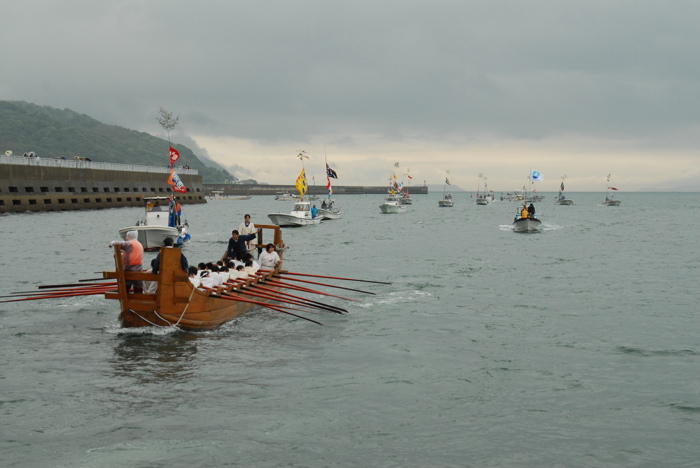
Fishing fleet and traditional rowing canoe follow Hokule'a to sea. Photo by Kaimana Barcarse
Thoughts of a Student from Sumiyoshi Middle School, Kumamoto
I had never imagined that a canoe can travel all the way from Hawaii to Japan just by using wind. But by listening to a lecture yesterday and watching DVD and pictures of Hokule’a, I learned that it is possible! I was so touched and inspired by the greatness of traditional methods [of navigation]
Also, I was surprised to learn that the canoe was not a luxurious one, but was made of wood. I was surprised to learn that there are 4 types of navigation techniques. I was deeply touched by that fact that navigators figure out direction by referring to the location of stars and the sun, as well as birds and ocean current. To become such navigators takes a great deal of efforts and time (30 years!).
Traveling from Hawaii to Japan on a canoe must be hard, but I imagine traveling like that feels so free. I found myself drawn to such a way of living feeling stars, ocean and wind with all my being and use them to guide me. I learned from the stories of the Hokule’a the importance of working together with people, to be courageous in facing whatever life offers us, and to have a vision and find a way to get there. Also, I am curious to learn more about tradition and cultural heritage.
The night I attended the lecture, I looked up to the sky to find stars. They were so beautiful that I wanted to keep on looking at them. I am so proud that I live in a beautiful place called Sumiyoshi, which is richly endowed with nature. I want to continue to treasure this special place.
ホクレア号の取り組みの講演を聴いて
私は今までハワイから日本まで風だけで来るなんて無理だと思っていました。昨日講演を聴いたり、実際の写真やDVDで取り組みの様子を聴いて、可能なことなのだということが分かり、伝統的な方法の偉大さに感動しました。
また、豪華船ではなく木材で作ってあり、航海術も4種類もあって驚きました。その他にも星や太陽の位置で方角を割り出したり、鳥や海の流れなども判断材料にするのにも感動しました。そんな凄い航海士になるのに30年も長い訓練が必要なんだと聞いて、努力が必要なのだなと思いました。
ハワイから日本まで大変だと思うけど、なんか自由な感じがいいなと思いました。星や海風を体中で感じて進むという生き方にもとても魅力がありました。人と協力することの大切さ、何事にも勇気を持ってやるということや目標を定めてそれに向かって進んでいくということを真似して、夢に向かって歩いていこうと思います。また、昔の伝統にも興味を持って調べて行きたいと思います。
講演を聴いた後 夜 星を見ました。とてもきれいでずっと見ていたかったです。このような自然いっぱいの住吉に住んでいることを誇りに思い、これからもずっと大好きでいようと思いました。
熊本県宇土市立住吉中学校

